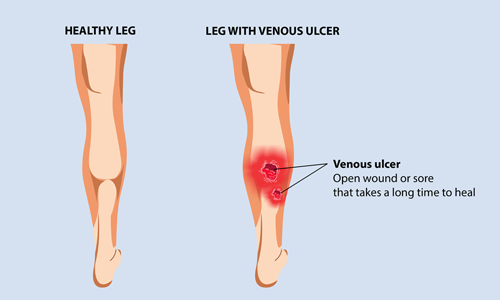Venous Leg Ulcer

Venous leg ulcers are a common chronic condition that can significantly impact a person’s quality of life. These ulcers occur due to impaired circulation in the legs, leading to poor blood flow and subsequent tissue damage. If left untreated, venous leg ulcers can cause pain, infection, and long-term complications. Fortunately, Smiles Hospitals offers effective treatment options to address this condition and promote healing.
Understanding Venous Leg Ulcers
Venous leg ulcers are open sores that develop on the lower legs due to venous insufficiency. This condition occurs when the valves in the leg veins are unable to efficiently return blood back to the heart. As a result, blood pools in the legs, leading to swelling, inflammation, and the formation of ulcers over time.
Causes and Risk Factors
Several factors contribute to the development of venous leg ulcers. The primary cause is chronic venous insufficiency, which can be a result of damaged vein valves or weakened vein walls. Other risk factors include obesity, a history of deep vein thrombosis (DVT), prolonged standing or sitting, age, gender (women are more prone), and a family history of venous leg ulcers.
Signs and Symptoms
- Open, shallow sores on the lower legs
- Irregular-shaped ulcers with a red or yellowish base
- Swelling and pain in the affected area
- Itching and tenderness around the ulcer
- Discolored and hardened skin around the ulcer
- Foul-smelling discharge from the ulcer
Diagnosis
To accurately diagnose venous leg ulcers, healthcare professionals at Smiles Hospitals will conduct a thorough examination of the affected leg. This may include evaluating the patient’s medical history, assessing the ulcer’s appearance, and performing tests such as Doppler ultrasound to assess blood flow and identify any underlying vein abnormalities.
Importance of Timely Treatment
Timely treatment of venous leg ulcers is crucial to prevent complications and promote healing. Without proper care, these ulcers can become chronic, leading to infection, cellulitis (skin infection), and the development of non-healing wounds. Seeking treatment at Smiles Hospitals at the earliest signs of venous leg ulcers can help improve outcomes and prevent further complications.
Non-Surgical Treatment Options
Smiles Hospitals offers various non-surgical treatment options for venous leg ulcers. These may include:
Compression Therapy
Compression therapy involves the use of specialized stockings or bandages to apply pressure on the legs, improving blood flow and reducing swelling. It helps prevent blood from pooling in the lower limbs and aids in the healing process of the ulcers.
Wound Dressings
Advanced wound dressings are used to create a moist environment around the ulcer, promoting healing and preventing infection. These dressings may be tailored to the specific needs of the patient and can be combined with compression therapy for enhanced effectiveness.
Medications
Certain medications, such as pentoxifylline, may be prescribed to improve blood flow and promote ulcer healing. These medications work by reducing inflammation and improving the circulation in the affected area.
Surgical Treatment Options
In some cases, surgical intervention may be necessary to treat venous leg ulcers effectively. Smiles Hospitals provides the following surgical treatment options:
Venous Surgery
Venous surgery aims to repair or bypass damaged veins, restoring proper blood flow and reducing the risk of ulcer recurrence. Procedures such as vein ligation and stripping or endovenous ablation may be performed based on the patient’s condition and individual needs.
Skin Grafting
Skin grafting involves transplanting healthy skin from another part of the body to cover the ulcerated area. This promotes healing by providing a healthy tissue bed for regeneration and reduces the risk of infection.
Rehabilitation and Wound Care
Following treatment, rehabilitation and wound care play a crucial role in the healing process. Smiles Hospitals offers comprehensive wound care management, including regular follow-up visits, wound cleaning and dressing changes, and patient education on self-care measures to prevent recurrence.
Prevention and Lifestyle Changes
- Regular exercise to improve leg muscle strength and circulation
- Maintaining a healthy weight to reduce pressure on the veins
- Avoiding prolonged periods of standing or sitting
- Elevating the legs whenever possible to promote blood flow
- Wearing compression stockings as recommended by healthcare professionals
- Advancements in Venous Leg Ulcer Treatment
- Ongoing research and advancements in medical science have led to innovative treatment options for venous leg ulcers.
- Smiles Hospitals stays at the forefront of these developments, ensuring patients benefit from the latest techniques, therapies, and interventions to achieve optimal outcomes.
Why Choose Smiles Hospitals
- Highly skilled medical professionals experienced in managing venous leg ulcers
- State-of-the-art facilities and advanced diagnostic tools for accurate assessment
- Comprehensive treatment plans tailored to individual needs
- Collaborative and patient-centered care approach
- Supportive environment and compassionate staff
Conclusion
Venous leg ulcers can significantly impact a person’s well-being, but with timely and appropriate treatment, healing and recovery are possible. Smiles Hospitals offers a wide range of treatment options, including non-surgical and surgical interventions, along with comprehensive wound care and rehabilitation services. By choosing Smiles Hospitals, patients can receive personalized care from experienced professionals dedicated to restoring their health and improving their quality of life.
FAQ'S
Common complications include infection, cellulitis, deep vein thrombosis (DVT), and non-healing wounds.
The healing time can vary depending on the size and severity of the ulcer. It may take several weeks to months for complete healing.
Yes, there is a possibility of recurrence if the underlying cause, such as venous insufficiency, is not addressed. Proper preventive measures and follow-up care can help minimize the risk.
While home remedies cannot replace medical treatment, certain measures like leg elevation, regular exercise, and maintaining good hygiene can support the healing process. It’s essential to consult a healthcare professional for proper evaluation and guidance.
The coverage may vary depending on the insurance plan. It’s advisable to check with the insurance provider to understand the specific coverage details and reimbursement options.
